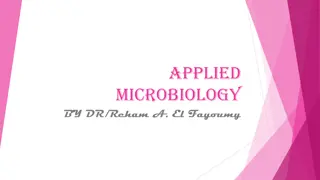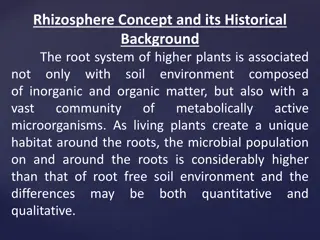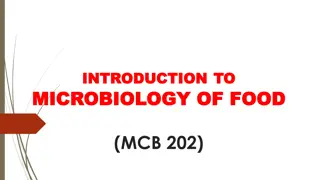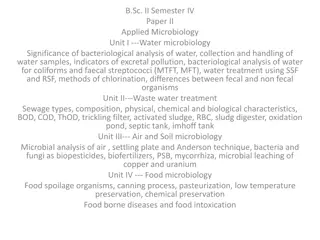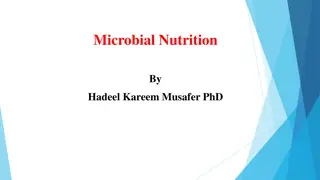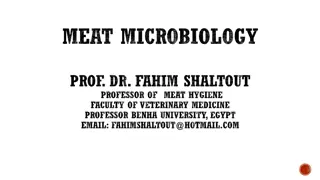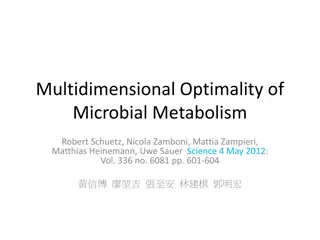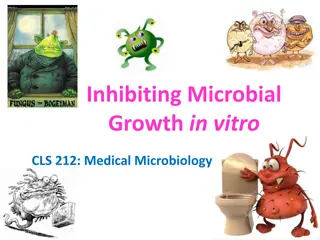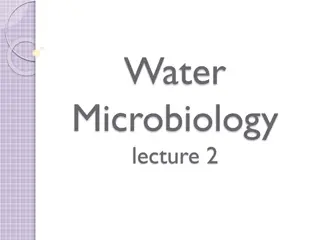Exploring the Fascinating World of Food Microbiology and Microbial Habitats
Delve into the intriguing realm of food microbiology, uncovering how fermentation microbes can positively influence food properties, the importance of microbiological quality assurance, and the diverse habitats where microorganisms thrive. Learn about the impact of microflora on food quality and safety, the roles of microbes in recycling organic materials, and their contribution to maintaining the stability of the biosphere.
Download Presentation

Please find below an Image/Link to download the presentation.
The content on the website is provided AS IS for your information and personal use only. It may not be sold, licensed, or shared on other websites without obtaining consent from the author. Download presentation by click this link. If you encounter any issues during the download, it is possible that the publisher has removed the file from their server.
E N D
Presentation Transcript
UNIVERSITY OF BASRAH / COLLEGE OF SCIENCE lecture 2 The Scope of Food Microbiology Department of Pathological Analyses
Fermentation Microbes can however play a positive role in food. They can be consumed as foods in themselves as in the edible fungi, mycoprotein and algae. They can also effect desirable transformations in a food, changing its properties in a way that is beneficial. Microbiological quality assurance Food microbiology is an applied science and the food microbiologist s principal function is to help assure a supply of whole- some and safe food to the consumer.
Micro-organisms and food materials Foods, by their very nature, need to be nutritious and metabolizable and it should be expected that they will offer suitable substrates for the growth and metabolism of micro-organisms. It is useful to examine the possible sources of micro-organisms in order to understand the ecology of contamination.
Diversity of Habitat Micro-organisms can be found in various habitats, including cold ponds and boiling hot springs. Actively growing bacteria can occur at temperatures exceeding 100 C in thermal volcanic vents. Micro-organisms can be found in acidic wastes, alkaline soda lakes, estuarine muds, and unproductive lakes, as well as in black anaerobic silts. In all these, and many other, habitats microbes play an important part in the recycling of organic and inorganic materials through their roles in the carbon, nitrogen and sulfur cycles .
Diversity of Habitat Micro-organisms can be found in various habitats, including cold ponds and boiling hot springs. Actively growing bacteria can occur at temperatures exceeding 100 C in thermal volcanic vents. Micro-organisms can be found in acidic wastes, alkaline soda lakes, estuarine muds, and unproductive lakes, as well as in black anaerobic silts. In all these, and many other, habitats microbes play an important part in the recycling of organic and inorganic materials through their roles in the carbon, nitrogen and sulfur cycles . Thus play an important part in the maintenance of the stability of the biosphere.
Diversity of Habitat Surfaces of plant structures such as leaves, flowers, fruits and especially the roots, as well as the surfaces and the guts of animals all have a rich microflora of bacteria, yeasts and filamentous fungi. This natural, or normal flora may affect the original quality of the raw ingredients used in the manufacture of foods, the kinds of contamination which may occur during processing, and the possibility of food spoilage or food associated illness. Thus, in considering the possible sources of microorganisms as agents of food spoilage or food poisoning, it will be necessary to examine the natural flora of the food materials themselves, the flora introduced by processing and handling, and the possibility of chance contamination from the atmosphere,soil or water.


